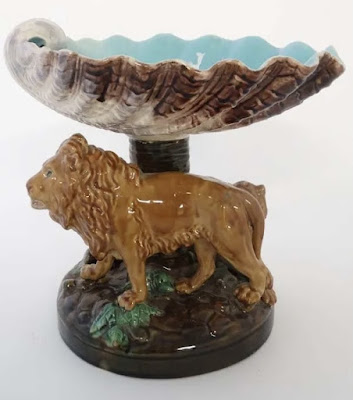Over the years many books on majolica have crossed my path. Of all of them, the paperback
Majolica, by Mike Schneider and Schiffer Publishing, has to be the worst I have seen. Filled with incredibly bad photos of incredibly dull pieces and awful misinformation,
Majolica is a disaster.
Now Mr. Schneider seems like a nice enough fellow, and I'm sure he is, but according to what information is available, Mr. Schneider is a contract writer. Nowhere in his biography is there any mention of any background in antiques, yet he is the author of nine books on antiques, as diverse as salt and pepper shakers, Stangl birds and Grindley pottery. In colloquial terms, some might call this kind of work hack writing: a writer hired to produce routine commercial writing.
I don't mean to be harsh on the fellow, I don't know him. Certainly he is only trying to make an honest living as a freelance writer, but unfortunately his lack of background in antiques comes through crystal clear in the text of
Majolica. He claims to have three pieces of majolica in his own collection, but he never claims to have any personal knowledge of the subject.
He is a good writer however, which goes a long way towards covering his inexperienced tracks but when you are writing a book about a specific subject, particularly one with a devoted following like majolica, one's passion needs to come through the page. Schneider's passion is as absent as cheese on the moon.
The book starts out promisingly enough. In the preface, Schneider waxes poetic about the young girls who may have painted the majolica you hold in your hand. It's a lovely little piece that instills a sense of marvel into the subject. Unfortunately, the elegant writing soon gives way to routine rehashes of the origin of majolica and the various forms that are available, all without any insight. This would have been forgivable were it not for the exceptionally bad choice of pieces for the book, flat photos, terrible captions and poor design that make up the bulk of the reference.
I have never seen such an undistiguished selection of majolica pieces in a majolica book. Most of the photos look like they were taken by a maiden aunt with her flash camera on the dining room table. I see far better images on eBay. It is absolutely appalling that photos this poor would find themselves in a reference publication.
As for the inaccuracies in the caption text, the book has no equal. A piece of creamware is identified as "the plainest piece of majolica you'll ever see." Staining is routinely identified as crazing while a 10" Continental corn pitcher is identified as "either unmarked Etruscan or an Etruscan copy." He claims that the Etruscan
Shell pitcher came in three sizes. That should come as news to those who have
Shell pitchers in ten more sizes. There seems to be more accuracy in crediting the owners of the pieces than in discussing the pieces themselves.
The paperback's design is another disaster. First of all the cover is what we used to call "pig ugly" when I was a child. Pictures inside are all different sizes, some with borders, some without, some bleeding off the page, some centered. The captions are carelessly centered below the images with no uniformity to the distance between the image and the caption or the amount of white space on the page. If a designer presented this to me as a portfolio piece I would take their business card and toss it right into the trash.
It's a shame that a reference this bad would be in its fourth edition with a four star overall rating on Amazon. I can only assume that some people have extremely low expectations about their majolica reference material. In my opinion it's an insult to readers, authors and the subject itself.
Majolica by Mike Schneider; Schiffer Publishing; 4th Revised edition; 144 Pages; $14.95







































































